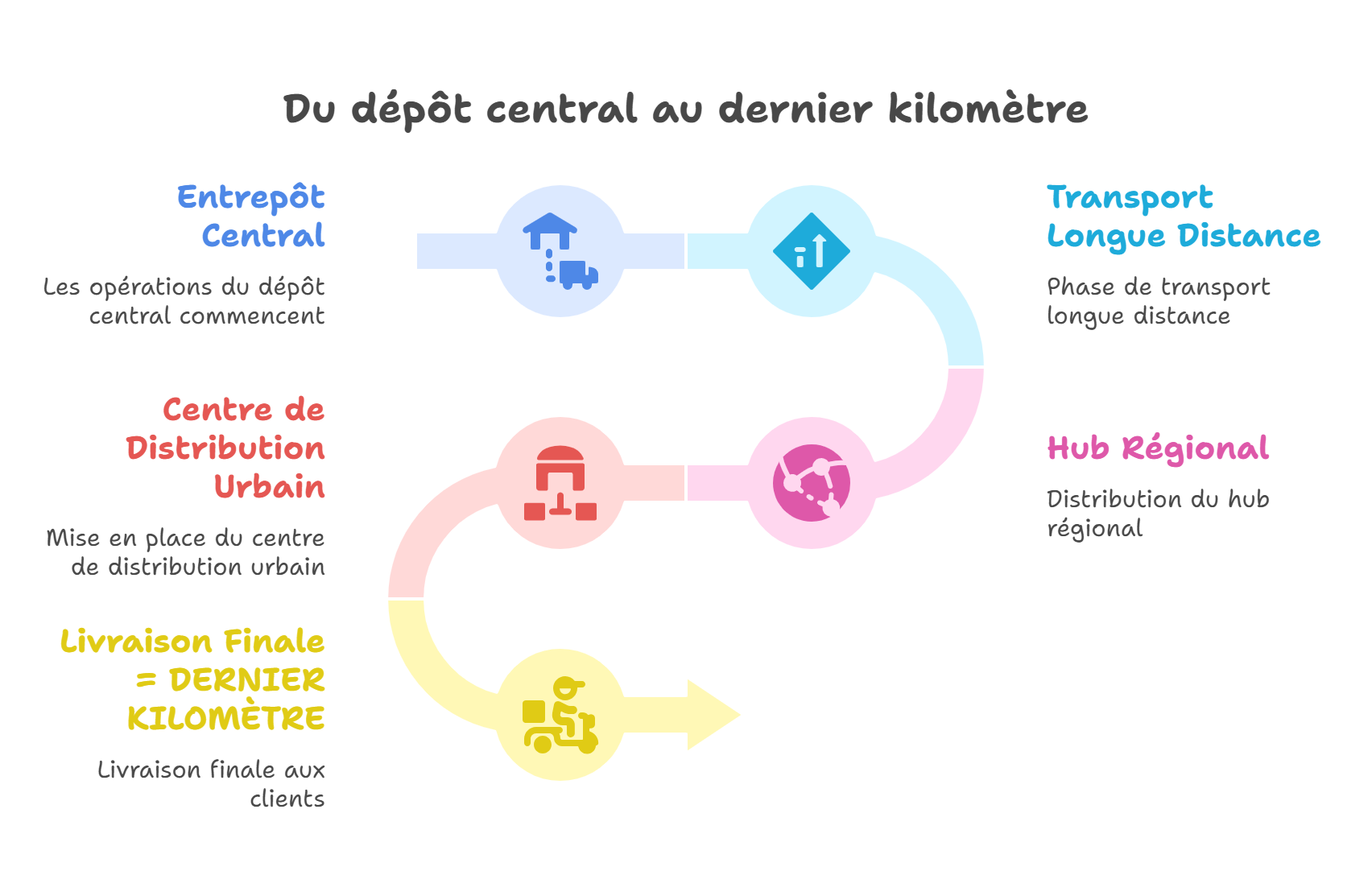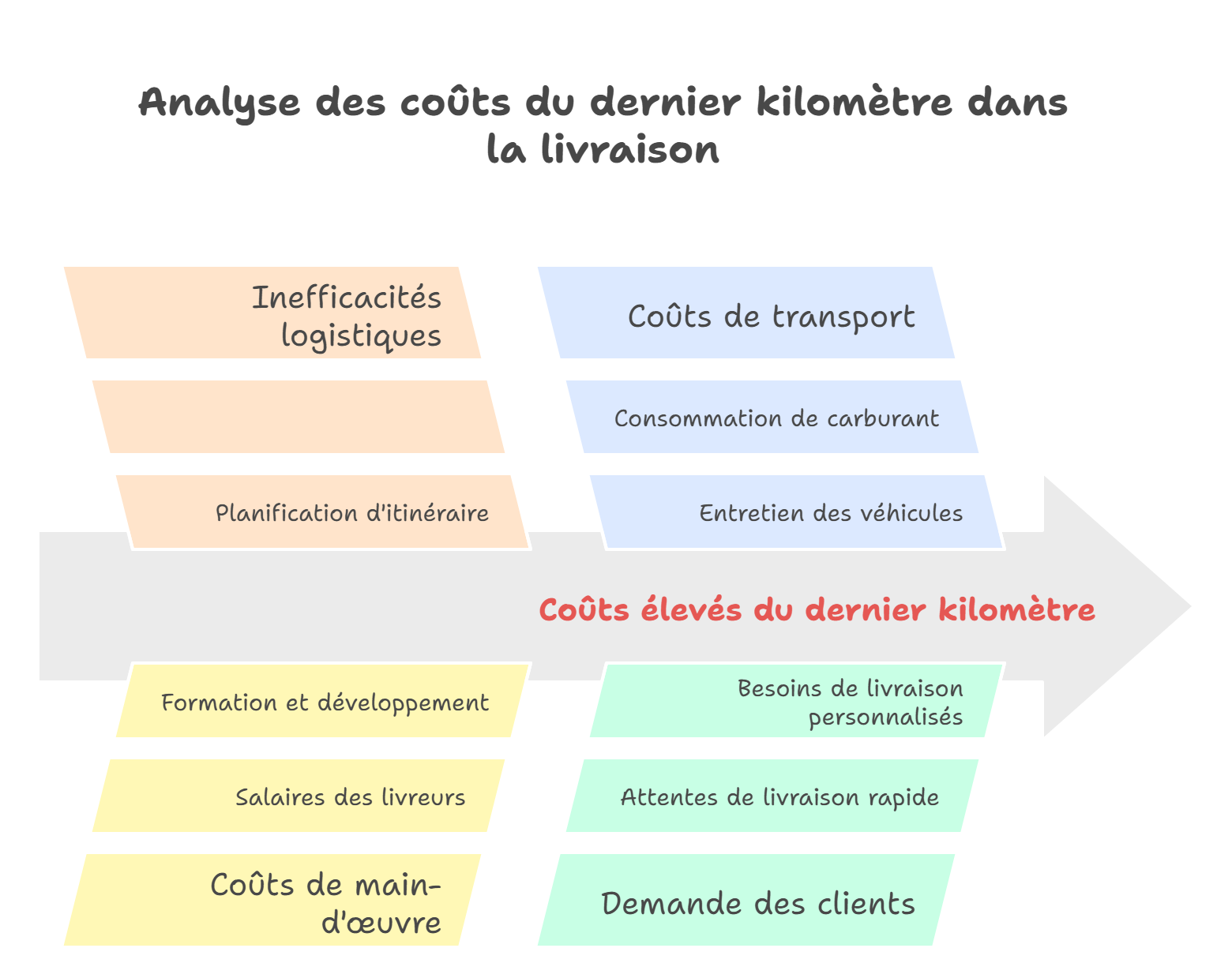Updated July 2025
The "Last Mile". This term, once confined to the circles of logisticians, is now at the heart of our digital economy. It is the shortest, most expensive and most complex stage of the entire supply chain. It's the moment of truth when a digital promise is transformed into a physical experience. It is, without exaggeration, the battlefield where customer loyalty and corporate profitability are won and lost.
Mastering the "last mile" is no longer an option; for over a decade it has been a condition of survival. This guide is not just an overview. It's the start of a deep dive into the last-mile ecosystem, to give you the keys to understanding and taking action, now and especially in the crucial decade ahead.
Definition: What is the "Last Mile" and why is it so strategic?
The "last mile" refers to the final stage of the delivery process, when a parcel leaves a local distribution center (hub, urban warehouse - the yellow stage below) to arrive at its final destination: the home of a private individual or the premises of a company.

If it is the shortest in distance, it has become the center of gravity of logistics for three reasons:
- It is the only physical point of contact with the end customer (customer experience).
- This is the most inefficient and costly stage of the entire chain (the least shared stage).
- This is where all modern expectations crystallize: speed, flexibility, and ecological responsibility (the fruit of an order placed several hours ago and therefore the end of waiting).
The Last Mile in Figures: A booming market
The figures illustrate the colossal importance of this segment:
- Global market size: Estimated at over $200 billion in 2025, it should reach nearly $325 billion by 2029 (Source : Mordor Intelligence)
- The weight of costs: On average, the last kilometer accounts for over 50% of the total cost of delivery. It's the most expensive link
- Customer demand: 66% of retailers are now under pressure to offer next-day delivery, and 44% of consumers expect their parcels in less than 2 days.
This growth is driven by the rise of e-commerce, urban densification and our collective appetite for "fast delivery".

Here are a few figures to illustrate these cost items:
- Drivers' wages account for almost 40% of the marginal cost, and fuel for 25%. Each failed delivery (customer absence) doubles this cost.
- 66% of retailers are now under pressure to offer next-day delivery, and 44% of consumers expect their parcels in less than 2 days.
The 4 Major Challenges of the Last Mile
Optimizing the last mile means solving a complex equation with four major variables.
- The Urban Challenge: Traffic congestion, lack of parking spaces, traffic restrictions (Low Emission Zones - LEZ), and the complexity of delivering dozens of single points within a restricted perimeter.
- The Economic Challenge: Costs are atomized and high. Drivers' wages account for almost 40% of marginal costs, and fuel for 25%. Each missed delivery (absent customer) doubles this cost.
- The Environmental Challenge: Freight transport is a major contributor to CO₂ emissions in cities. Regulatory and citizen pressure for decarbonization is immense
- The Customer Experience Challenge: Delays, package theft ("porch pirates"), damage... The last mile is the area where risks to the parcel and customer satisfaction are highest
Into the future (2025-2030): Trends and prospects
Tomorrow's last mile will be hyper-personalized, collaborative and sustainable.
- Hyper-customization: Customers can choose their delivery slot down to the minute, change their destination in real time and communicate directly with the delivery driver.
- Collaborative Ecosystems: Public/private partnerships will be set up to create shared delivery hubs and regulate delivery vehicle traffic.
- Environmental regulations: The extension of EPZs and the introduction of urban carbon taxes will make green logistics an obligation rather than an option.
Risk Management: Insurance as the Last Mile Safety Net
The last kilometer is the zone of all dangers: theft, loss, breakage. Traditional insurance is inadequate. The future belongs to solutions:
- Digital and instant: Underwriting and claims reporting in just a few clicks
- Integrated: natively connected to logistics tools (TMS, OMS) for automated management
- Ad Valorem: Covering the actual value of the property, not a derisory lump sum
Players like Claisy (unique in Europe, like Route.com or Shipsurance in the USA) specialize in this approach, transforming insurance from a cost center into a management and customer satisfaction tool.
Conclusion: The Last Mile, a strategic lever
The last mile is no longer just an operational issue. It is now a major strategic lever. Tomorrow's successful companies will not be those who deliver the fastest or the cheapest, but those who manage to orchestrate an efficient, sustainable "last mile" focused on an irreproachable customer experience. Investing in the optimization of this final link means investing directly in the growth and sustainability of your business.


